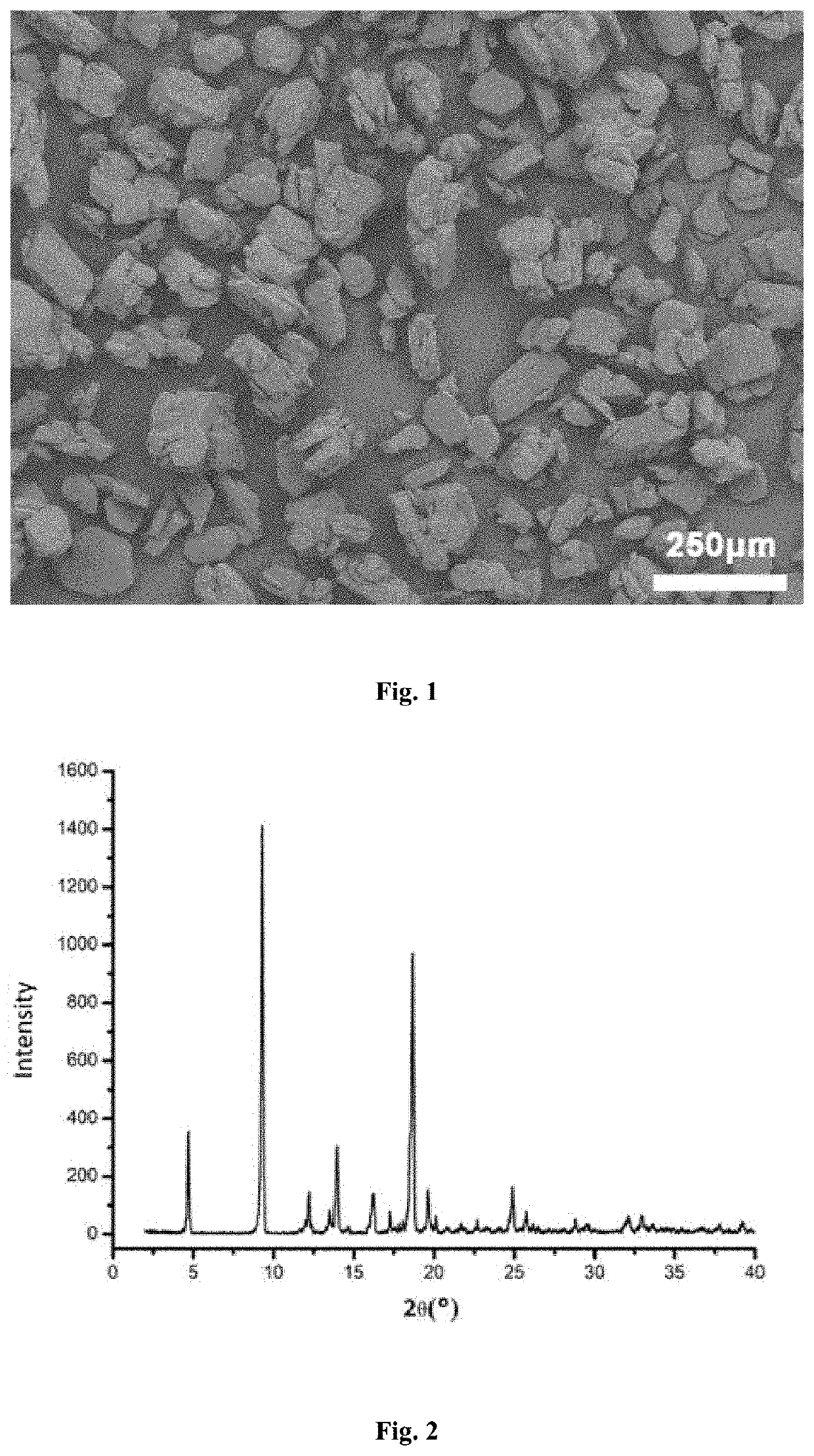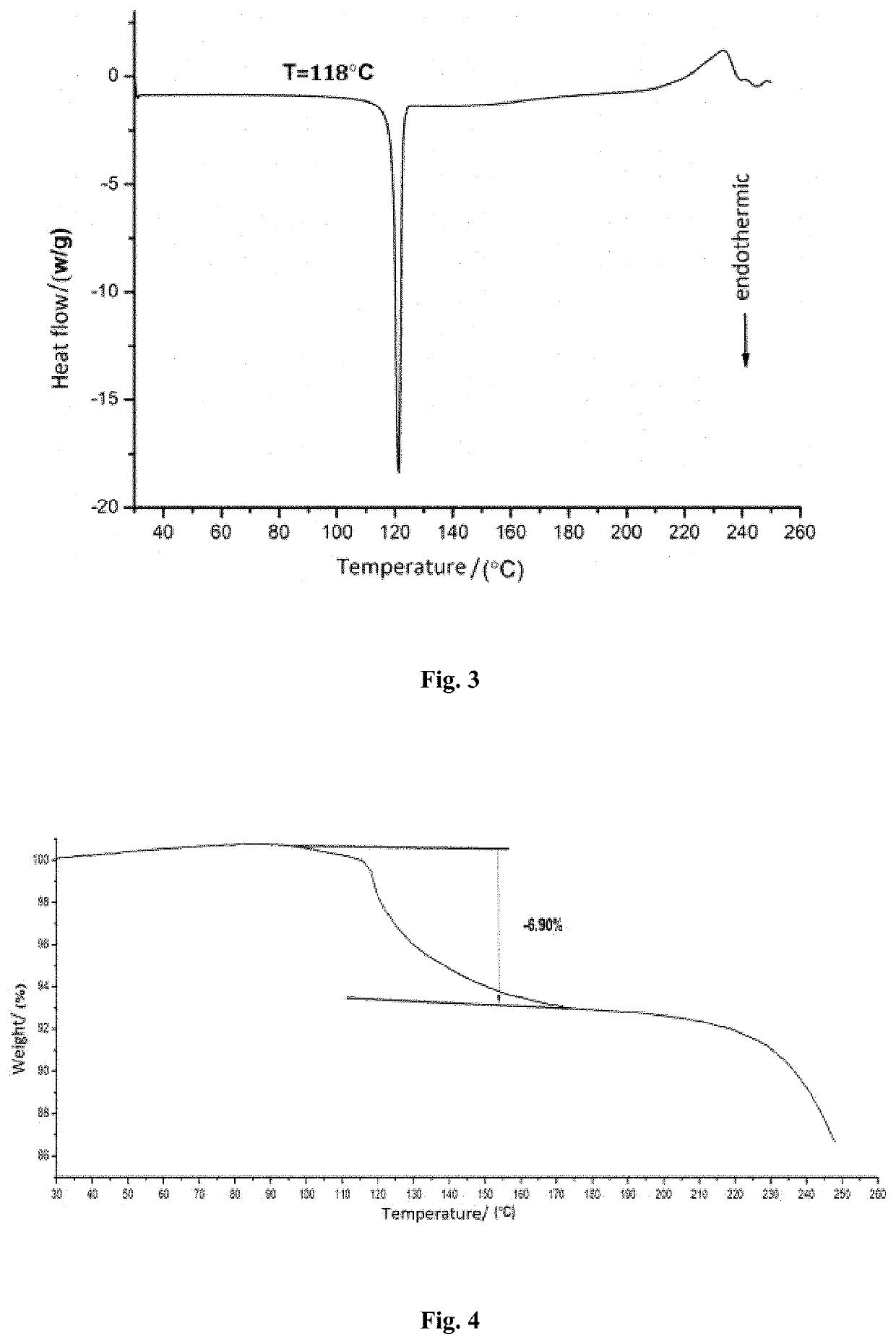Crystalline Form of Phenyl Bis (2,4,6-Trimethylbenzoyl) Phosphine Oxide With Large Particle Size and Crystallization Method for Making Same
- Summary
- Abstract
- Description
- Claims
- Application Information
AI Technical Summary
Benefits of technology
Problems solved by technology
Method used
Image
Examples
example 1
[0045]5.4 g of phenyl bis (2,4,6-trimethylbenzoyl) phosphine oxide in the crystalline form I was dissolved in 34 mL of acetone and stirred with a stirring speed of 100 rpm. The mixture was heated to 50° C. to completely dissolve the solid therein and was then cooled to room temperature. 64 mL of n-heptane as an anti-solvent was added to the solution at a rate of 19 mL / min to precipitate crystals of phenyl bis (2,4,6-trimethylbenzoyl) phosphine oxide. After completion of the addition, the precipitated crystals were allowed to grow at a constant temperature for 30 minutes. The resulting slurry containing the crystals was subjected to filtration. The filter cake was dried under vacuum at 60° C. to constant weight to obtain a crystal product of phenyl bis (2,4,6-trimethylbenzoyl) phosphine oxide.
[0046]It was found that the crystal product of phenyl bis (2,4,6-trimethylbenzoyl) phosphine oxide obtained in this Example had an X-ray powder diffraction pattern with characteristic peaks at a...
example 2
[0047]9 g of phenyl bis (2,4,6-trimethylbenzoyl) phosphine oxide in the crystalline form I was dissolved in 69 mL of methyl acetate and stirred with a stirring speed of 300 rpm. The mixture was heated to 70° C. to completely dissolve the solid therein and was then cooled to room temperature. 207 mL of ethanol as an anti-solvent was added to the solution at a rate of 0.4 mL / min to precipitate crystals of phenyl bis (2,4,6-trimethylbenzoyl) phosphine oxide. After completion of the addition, the precipitated crystals were allowed to grow at a constant temperature for 10 minutes. The resulting slurry containing the crystals was subjected to filtration. The filter cake was dried under vacuum at 50° C. to constant weight to obtain a crystal product of phenyl bis (2,4,6-trimethylbenzoyl) phosphine oxide.
[0048]It was found that the crystal product of phenyl bis (2,4,6-trimethylbenzoyl) phosphine oxide obtained in this Example had an X-ray powder diffraction pattern with characteristic peaks...
example 3
[0049]5.4 g of phenyl bis (2,4,6-trimethylbenzoyl) phosphine oxide in the crystalline form I was dissolved in a mixed solution of 19 mL of 2-butanone and 19 mL of ethyl acetate and stirred with a stirring speed of 50 rpm. The resulting mixture was heated to 60° C. to completely dissolve the solid therein and was then cooled to room temperature. 15 mL of glycol as an anti-solvent was added to the solution at a rate of 6.8 mL / min to precipitate crystals of phenyl bis (2,4,6-trimethylbenzoyl) phosphine oxide. After completion of the addition, the precipitated crystals were allowed to grow at a constant temperature for 60 minutes. The resulting slurry containing the crystals was subjected to filtration. The filter cake was dried under vacuum at 55° C. to constant weight to obtain a crystal product of phenyl bis (2,4,6-trimethylbenzoyl) phosphine oxide.
[0050]It was found that the crystal product of phenyl bis (2,4,6-trimethylbenzoyl) phosphine oxide obtained in this Example had an X-ray ...
PUM
| Property | Measurement | Unit |
|---|---|---|
| Temperature | aaaaa | aaaaa |
| Temperature | aaaaa | aaaaa |
| Temperature | aaaaa | aaaaa |
Abstract
Description
Claims
Application Information
 Login to View More
Login to View More - R&D
- Intellectual Property
- Life Sciences
- Materials
- Tech Scout
- Unparalleled Data Quality
- Higher Quality Content
- 60% Fewer Hallucinations
Browse by: Latest US Patents, China's latest patents, Technical Efficacy Thesaurus, Application Domain, Technology Topic, Popular Technical Reports.
© 2025 PatSnap. All rights reserved.Legal|Privacy policy|Modern Slavery Act Transparency Statement|Sitemap|About US| Contact US: help@patsnap.com



